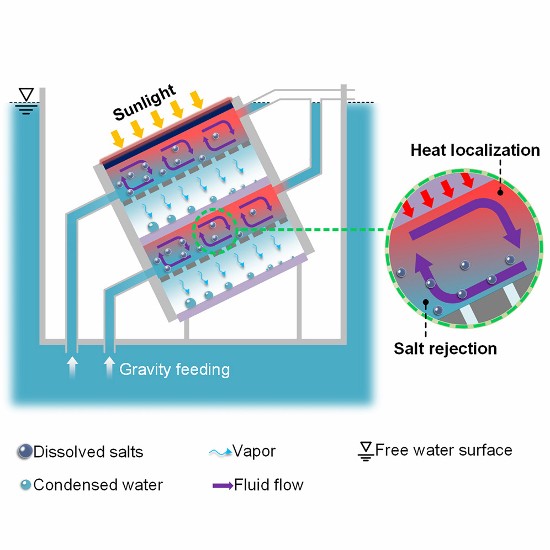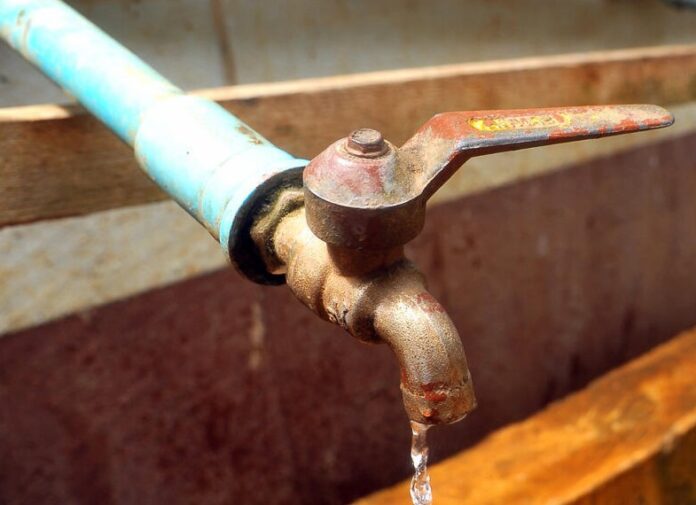Massachusetts Institute of Technology (MIT) and Shanghai Jiao Tong University (SJT) have designed a device to produce enough drinking water from seawater for daily family use. It is portable and can run off the grid.
How does it work? It converts sunlight to energy that then evaporates the seawater creating water vapour and leaving the salt behind. It uses convection in the same way it happens in the ocean in a thermohaline process that is caused when sunlight strikes the surface of the ocean causing vaporization with the salt left behind to drift downward to form layered concentrations in the water column.

The device uses the same thermohaline process in a suitcase-sized form factor. It doesn’t need multiple ocean layers, just two. The upper layer contains the evaporator, a dark membrane that causes vaporization. The water vapour is then channelled to the second layer where a condenser cools it turning it back into water but this time without salt.
The device is tilted which creates a current within it. The constant movement of the water doesn’t allow the salt to settle at the bottom and eventually clog its operation. Instead, the salt is flushed continuously from the device as new saltwater is drawn upward through channels to the upper layer to repeat the cycle. In a one-square-metre-sized version, its inventors state it will produce 5 litres of freshwater hourly and operate indefinitely.
The device is passive, runs without electricity, is portable, simple to replicate and inexpensive. What’s not to like in a world where freshwater comes at a premium?
Freshwater: The Increasingly Scarce Resource on Planet Earth
For the water world that Earth is, very little is liquid, fresh and flowing. If you don’t believe me, here are some freshwater facts:
- Only 3% of all the water on the planet is fresh and can be found in rivers, lakes, and underground. The rest is salty.
- Of that 3%, two-thirds is frozen in alpine glaciers, ice caps, and sea ice.
- Coastal aquifers provide groundwater which is increasingly being inundated by saltwater intrusion as global warming causes sea levels to rise.
- Globally, we consume 10 billion tons of freshwater daily and 4 trillion cubic metres annually.
- In 2022, 73% of the global population (about 6 billion) had on-premise safe drinking water facilities.
- In 2021, 2 billion people were living in water-stressed countries.
- In 2022, 1.7 billion people were using contaminated drinking water sources containing feces.
- A lack of freshwater for washing is a key contributor to diarrheal diseases, acute respiratory infections and tropical diseases.
- Contaminated drinking water transmits diseases like diarrhea, cholera, dysentery, typhoid and polio leading to 505,000 deaths annually.
- Another 324,000 die annually from other things found in using unsafe water for drinking, cooking and washing.
- Because of freshwater scarcity, approximately 16,000 desalination plants are operating in 177 countries generating an estimated 95 million cubic metres of freshwater daily.
Desalination technology is expensive to build, power and maintain. That’s what makes this promising micro-desalination technology so exciting.
Guihua You, a researcher working on sustainable water and energy storage systems at the University of Texas-Austin, when he found out about the MIT-SJT invention described it as follows:
“This is a very innovative approach that effectively mitigates key challenges in the field of desalination…The design is particularly beneficial for regions struggling with high-salinity water. Its modular design makes it highly suitable for household water production, allowing for scalability and adaptability to meet individual needs.”
















